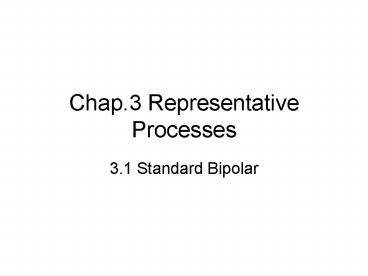Chap'3 Representative Processes - PowerPoint PPT Presentation
1 / 19
Title:
Chap'3 Representative Processes
Description:
... substrate also defines N Tank ... C=N-epi tank; B=Pbase, counter ... Emitter diffusion, both in common tank. Vbr = 7V. Depends on bias, varies ... – PowerPoint PPT presentation
Number of Views:39
Avg rating:3.0/5.0
Title: Chap'3 Representative Processes
1
Chap.3 Representative Processes
- 3.1 Standard Bipolar
2
1. Essential Features
- Optimized for NPN, at the expense of PNP
- But, PNPs were still built from existing steps
does the job, even though relatively poor
performance. - NPN
- JI Junction isolation isolate current flow
between this and other devices P isolation - JI-P touches underlying substrate also defines
N Tank - JI P side is lower potential than N side
(reverse bias)
3
2. Fab Sequence
- Starting Material
- Lightly doped (111) Si P-type
- Off-cut a few degrees to minimize NBL shadow
distortion - (111) suppresses parasitic PMOS (N-epi is the
Backgate of this PMOS, metal-1 over the FOX is
Gate, P-base is the Source, and P Iso is the
Drain. Vt thick field threshold) - (111) has high Thick-Field Threshold due to
positive Qit, at Oxide-Si interface.
4
2. Fab Sequence, contd
- N-Buried Layer
- NBL mask on oxide
- NBL implant (As or Sb)
- NBL drive (anneal thin oxide on top later
cause NBL shadow) - Epi Growth
- N-type epi, 10-25 mm thick
- NBL shadow propagates at 45 degree angle (makes
lateral shift epi thickness)
5
2. Fab Sequence, contd
- Isolation Diffusion
- Mask aligned at offset from NBL shadow
- Heavy B deposition
- High Temp drive (also causes oxidation), which
stops before Iso junction touches substrate
6
2. Fab Sequence, contd
- Deep N sinker
- Deep-N mask
- Heavy Phosphorus deposition
- High Temp drive, causes deep N to meet NBL (25
overdrive), forms thick F.Oxide
7
2. Fab Sequence, contd
- Base Implant
- Base mask light Boron implant forms p-type Base
- Implant precise doping level minimizes
process derived Beta variation ! - Base drive anneal decides junction depth
- Base implant covers Isolation regions too (BOI
base-over-isolation) gt increases Thick field Vt
8
2. Fab Sequence, contd
- Emitter Diffusion
- Emitter mask concentrated P source (POCl3)
brief drive - Contact
- Contact mask oxide removal contact OR
- Metallization
- Evaporate or sputter Al-Cu-Si alloy over entire
wafer, at least 1 mm thick. - 2 Si suppress the Emitter punchthrough
- 0.5 Cu improves Electromigration resistance
- metal mask ? interconnection wires
9
2. Fab Sequence, contd
- Protective Overcoat (PO)
- Compressed Nitride or phophosilicate-doped glass
(PSG) PO over entire wafer - PO mask to open bonding areas
10
3. Available Devices
- NPN
- CN-epi tank BPbase, counter doping EN
diffusion - Base width set by diffusion depths lt min.
feature size - NBL and deep-N low Collector resistance
(minimum NPN lt 100W, power NPN lt 1W) - Distance from bottom of Base to top of NBL sets
max. op. voltage (50-80V typical). Epi thickness
sets Vceo 10V to 100V
11
3. Available Devices, contd
- NPN , contd
- Typical Parameter values of minimum-emitter NPN
- Drawn emitter area 100 mm2
- Peak Beta 150
- VA, Early volt. 120V
- Collector resistance (sat) 100W
- IC range for max. Beta 5mA 2 mA
- Vebo 7 V
- Vcbo 60V
- Vceo 45V
12
3. Available Devices, contd
- NPN , contd
- NPN as Diode
- CB-shorted Diode or diode-connected transistor
- Breakdown voltage Vebo 7V
- Fast switching speed
- Can be used as Zener Diode also (allow - .3V Vz
tolerance)
13
3. Available Devices, contd
- PNP
- Substrate PNP
- Non-isolated vertical PNP
- Vc Vsubstrate ! usually negative supply rail
- Base N-tank Emitter Pbase diffusion
- Ic exits from Substrate gt substrate debiasing !
- Base width Epi thickness Emitter (Pbase)
diffusion - Do not use NBL
14
3. Available Devices, contd
- Typical parameters in 40V Stand.Bipolar
- Device Lat_PNP Sub_PNP
- Drawn emitter area 100mm2 100mm2
- Drawn base width 10mm N/A
- Peak Beta 50 100
- VA 100V 120V
- IC for max. Beta 5-100mA 5-200mA
- Vebo 60V 60V
- Vcbo 60V 60V
- Vceo 45V 45V
15
3. Available Devices, contd
- Lateral PNP
- Better isolation, worse performance than
Substrate PNP - BN-tank
- E, C Pbase diffusion into N-tank single mask
- Base width separation of E C (Pbase)
diffusions - Effective Base width ltlt drawn width due to
outdiffusion - Narrow-base lateral PNP low VA and low
punchthrough V. - Parasitic substrate_PNP
- Much current near surface where large Recomb.
Centers reside - Very slow due to large parasitic junction cap at
B terminal - PNP supporting role in analog ICs
16
3. Available Devices, contd
- Resistors (several types)
- Ohms per square, Sheet resistance. Typical values
5 to 5000 W/sq. - Base resistor N-tank, typical 150-250 W/sq.
- Emitter resistor in Emitter diffusion, isolated
by Pbase diffusion. Typical lt 10 W/sq.
differential voltage lt 6V - Pinched Base resistor R body in Pbase, but under
the Emitter diffusion. Can exceed 5000W/sq
(notoriously variable). Severe voltage
modulation. Differential voltage lt 7V.
17
3. Available Devices, contd
- Resistor Parameters
- Type Emitter Base Pinch
- Rs (Sheet R) 5 W/sq. 150W/sq. 3kW/s
- Min.dr.Width 8mm 8mm 8mm
- Vbr 7V 50V 7V
- Variability(15mm) 20 20 50 or more
18
3. Available Devices, contd
- Capacitors (one type)
- Base-Emitter Junction Capacitance, 0.8 fF/mm2
- Base diff. overlap Emitter diffusion, both in
common tank - Vbr 7V
- Depends on bias, varies - 50 or more
- Used in compensating feedback loops where high
Cap is needed.
19
4. Process Extension
- Up-Down Isolation
- Double-level Metal
- Schottky Diode
- High Sheet Resistors

